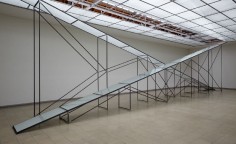Kilian Rüthemann
X
source: highlike
About: Rüthemann beschäftigt sich immer wieder mit der gegebenen Situation eines Ausstellungsortes. Er untersucht die architektonischen und räumlichen Qualitäten und greift durch präzise, minimale Interventionen auf überraschende Weise ins vorhandene Gefüge ein. So nimmt er Räume in Beschlag und beeinflusst subversiv die Wahrnehmung des Publikums. Er gehört zu einer jungen Generation von Kunstschaffenden, die sich erneut formalen und ästhetischen Fragestel- lungen in der Skulptur widmen, sich aber gleichzeitig für Transformations- und Auflösungsprozesse statt Statik und Dauerhaftigkeit interessieren. Die Werke bleiben meist temporäre Set- zungen, die nach der Ausstellung wieder in den Originalzustand zurück- versetzt werden. Die Transformation des Arbeitsmaterials entspricht quasi einer Veränderung seiner Aggregatszu- stände. Rüthemanns Interesse gilt dem Unsteten und Wandelbaren, dem Aufbau und Verfall – sowohl in seinen Werken als auch in der Architektur der Ausstellungsorte. Der Titel der Ausstel- lung (Deutsch: „lieber früher als später“) bezeichnet eine eigentümliche Zwischenzeit eines Prozesses, in welcher der Künstler seine Werke verortet. (Sabine Rusterholz).
Work: Iron, glass, 17 x 4.75 x 0.7m
Two glass panels are taken from the roof-construction and put on especially made iron scaffoldings.
Shown in the exhibition:
«Sooner Rather than Later», Kunsthaus Glarus. 2009
Potographer: David Aebi
.
.
.
.
.
.
.
source: kunsthausglarus
In his solo exhibition Kilian Rüthemann (b. 1979 in Bütschwil, lives in Basle) is showing new works as well as an intervention involving works from the collection of the Glarner Kunstverein.
In his works, Kilian Rüthemann always engages with the given situation of an exhibition space. He investigates the architectural and spatial qualities and in a surprising manner and makes precise, generally minimal interventions into the existing structure. In this way he monopolises the space and subversively influences the public’s perception. Rüthemann belongs to a new generation of young artists who are again devoting themselves to formal and aesthetic explorations in sculpture, but who are at the same time interested in processes of transformation and dissolution rather than stasis and permanence. The works generally remain temporary alterations which are returned to their original state after the exhibition. The transformation of the working material effectively corresponds to a change in its aggregate conditions. Rüthemann is primarily interested in the ephemeral and the changeable, build-up and decay – both in his works and in the architecture of the exhibition sites. The title of the exhibition refers to a specific interim period within a process during which the artist locates his works.
Since completing his training as a stonemason (1997-2001) and studying visual art and media at Basle College of Art and Design (2002-05), Rüthemann has won several prizes and grants, including the Iaab Exchange and Studio Grants (2008 in Berlin, 2007 in Istanbul), the Kiefer Hablitzel Foundation Prize (2008) and the Basle Manor Prize (2009). He has shown his works in a series of solo and group exhibitions, as for example in Kunsthaus Baselland (solo exhibition 2007), Kunsthalle Basel (group exhibition Poor Thing 2007) and the 5th Berlin Contemporary Art Biennale in 2008.
Kunsthaus Glarus is showing Rüthemann’s works for the first time in a solo exhibition outside of the Basle context.
.
.
.
.
.
.
.
.
source: beautifuldecay
Kilian Rüthemann was born in 1979 in Bütschwil, St. Gallen, Switzerland. Kilian always engages with the given situation of an exhibition space. He investigates the architectural and spatial qualities and in a surprising manner and makes precise, generally minimal interventions into the existing structure.
.
.
.
.
.
.
.
source: floresenelatico
Hoy reviso la obra de un artista que ya publiqué hace algún tiempo Killian Rüthemann, y que, como ha seguido realizando interesantes trabajos, vuelvo a traerlo de nuevo al Ático parar ampliar la información.Sigue trabajando sobre el mismo tipo de obra escultórica a partir de elementos arquitectónicos, basándose principalmente en el uso de distintos materiales constructivos como, hormigón, acero, yeso, acero espuma de poliuretano o incluso las propias paredes o los suelos, extrayendo todo el potencial que eston llevan implícitos. Con esta materia prima construye una obra que parece simple, casi minimalista y en la que subyace una gran fascinación por el material, que usa de manera muy gestual y táctil.


